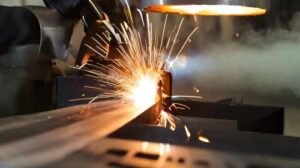Table of Contents
- Understanding the Perception of Difficulty
- Challenges in Learning Welding
- The Learning Curve in Welding
- Mastering Welding: Skill Development
- Professional Perspectives on Welding Difficulty
- Resources and Support for Learning Welding
- Breaking Down Common Myths about Welding
- Addressing Misconceptions and Myths
- Highlighting the Rewarding Aspects
- Conclusion: Unveiling the Reality of Welding
- Is welding only for experts or can beginners learn it too?
- How long does it take to become proficient in welding?
- Are there risks associated with welding, and how can one stay safe?
- Can someone learn welding without formal training?
- What are some common misconceptions about welding?
Welding, a cornerstone of numerous industries, is renowned for being challenging. The question looms. Is welding hard? This inquiry often deters aspiring welders. But let’s unveil the reality behind this perception.
Amidst misconceptions and daunting equipment, the perception of welding’s difficulty overshadows its potential. This article delves deep, debunking myths and illuminating the journey of mastering welding. Buckle up as we explore the truth behind whether welding is genuinely as hard as it seems.
Understanding the Perception of Difficulty
Common Misconceptions
Complex Nature of Welding
Welding’s perceived difficulty often arises from its technical nature. Many assume it involves an array of intricate skills beyond their grasp.
Intimidating Equipment
The sight of welding equipment—torches, protective gear, gas cylinders—can appear daunting to newcomers, contributing to the belief that welding is inherently hard.
Overemphasis on Precision
The need for precision in welding is often misconstrued as an insurmountable barrier. The idea of creating seamless, structurally sound joints intimidates beginners.
Factors Contributing to Perceived Difficulty
Technical Complexity
The intricate blend of science, metallurgy, and practical skills creates an aura of complexity around welding.
Risks Involved
Welding involves exposure to high temperatures, harmful fumes, and hazardous materials, which amplifies its perceived difficulty due to safety concerns.
Mastery Requirement
The expectation of achieving mastery in welding from the outset sets unrealistic standards, deterring many from attempting to learn.
Psychological Barrier
The fear of failure and the belief that one must possess innate skills to excel in welding contribute significantly to its perceived difficulty.
Addressing Misconceptions
Education and Awareness
Disseminating accurate information about the learning curve of welding can debunk myths and demystify its perceived difficulty.
Realistic Expectations
Encouraging beginners to view initial challenges as part of the learning process rather than insurmountable obstacles shifts the perspective on difficulty.
Highlighting Progression
Illustrating that proficiency in welding is an incremental process, where skills develop over time, fosters a more realistic understanding of its difficulty.
Emphasizing Support Networks
Promoting access to mentorship, training programs, and supportive communities shows that overcoming welding difficulty is achievable with guidance.
Challenges in Learning Welding
Learning welding presents individuals with various challenges, encompassing technical skills, safety concerns, and the amalgamation of theory with hands-on practice.
Technical Skills Required
Welding isn’t solely about fusing metals; it’s a craft demanding a multifaceted skill set. Understanding various welding techniques, comprehending material properties, and interpreting intricate designs are fundamental.
Mastery of Techniques
Different welding processes—MIG, TIG, Stick, etc.—require distinct techniques. Mastering each demands precision, control over heat, and a nuanced understanding of material behaviour under different conditions.
Material Understanding
It is essential to understand the characteristics of different metals—steel, aluminium, copper—and their reactions to heat. Each material demands specific approaches, influencing weld quality and durability.
Interpretation of Designs
Translating designs into physical welds demands the ability to accurately read and interpret blueprints, schematics, and welding symbols. This skill bridges theoretical knowledge with practical application.
Safety Concerns and Precautions
Safety is paramount in welding due to exposure to high temperatures, fumes, and potential hazards.
Protective Gear
Utilize appropriate personal protective equipment (PPE) such as helmets, gloves, aprons, and welding goggles to shield against heat, sparks, and harmful UV radiation.
Ventilation and Fume Extraction
Proper ventilation in welding spaces prevents the inhaling of toxic fumes generated during welding. Fume extraction systems are crucial in enclosed areas.
Hazardous Materials Handling
Handling gases, flammable materials, and hot metals necessitates adherence to safety protocols to prevent accidents and injuries.
Training in Safety Protocols
Learning safety practices is as crucial as mastering welding techniques. Understanding emergency procedures, fire safety, and first aid is indispensable.
Overcoming Challenges
The challenges in learning welding might seem daunting, but they’re surmountable with dedication and a structured approach.
Practice and Patience
Consistent practice and patience are essential. Starting with more straightforward techniques and gradually progressing to complex ones allows for gradual skill development.
Guidance and Mentorship
Seeking guidance from experienced welders or enrolling in formal training programs provides valuable insights and shortcuts to mastering the craft.
Embracing the Learning Curve
Understanding that initial struggles are part of the learning process is essential. Embracing challenges and learning from mistakes accelerates skill acquisition.
Continuous Learning
Welding, like any craft, is a continuous learning journey. Embracing new technologies, techniques, and advancements ensures staying at the forefront of the field.
While the technical and safety challenges in learning welding are substantial, overcoming them leads to a rewarding skill set and opens doors to diverse career opportunities.
The Learning Curve in Welding
Mastering welding involves navigating a learning curve encompassing initial struggles, skill development, and effective learning strategies.
Initial Struggles and Overcoming Obstacles
Acclimating to Equipment
Starting, the complexity of welding equipment can be overwhelming. The initial challenge is familiarizing oneself with various tools, their functions, and settings.
Precision and Consistency
Achieving precision in welds demands steady hands and consistent control over heat, speed, and technique, posing a significant challenge for beginners.
Understanding Material Behavior
The behaviour of different metals under heat and pressure isn’t intuitive. Learning how metals respond to welding processes is a gradual learning curve.
Overcoming Obstacles
The key to overcoming these initial hurdles is persistence. Embracing each challenge as a learning opportunity rather than a setback is crucial.
Effective Learning Strategies
Structured Learning Approach
Adopting a structured approach, starting with basic techniques and gradually progressing to more complex ones, helps build a strong foundation.
Hands-On Practice
Nothing beats hands-on practice. Spending ample time practising welds under supervision or guidance accelerates skill development.
Learning from Errors
Mistakes are inevitable but valuable. Analyzing and learning from errors enhances understanding and improves technique.
Seeking Guidance and Mentorship
Experienced welders’ guidance or enrolling in structured training programs provides insights and shortcuts, expediting learning.
Developing Mastery
Continuous Practice
Mastery in welding is a result of continuous practice. Devoting time consistently to refine techniques is crucial.
Experimentation and Innovation
Exploring new techniques, materials, and approaches fosters innovation and expands one’s welding prowess.
Refinement through Feedback
Receiving feedback from mentors or peers helps identify areas for improvement and further hone skills.
Embracing the Journey
Understanding that mastery takes time and dedication is vital. Embracing the journey rather than focusing solely on the destination is critical to sustained growth.
In essence, the learning curve in welding is steep initially but rewarding. Overcoming obstacles, adopting effective learning strategies, and embracing the continuous journey of skill refinement pave the path to becoming a proficient welder.
Mastering Welding: Skill Development
Mastering welding is a journey that demands dedication, continuous practice, and a commitment to honing one’s skills.
Continuous Practice and Refinement
Consistency in Practice
Consistent practice is the cornerstone of mastering welding. Regular exposure to welding techniques hones precision and skill.
Repetition for Mastery
Repeating welds and techniques instil muscle memory, enabling welders to execute tasks effortlessly and accurately.
Varied Projects
Tackling diverse projects exposes welders to different materials, joint types, and challenges, broadening their expertise.
Learning from Mistakes and Experiences
Embracing Errors as Lessons
Mistakes aren’t setbacks but opportunities to learn. Analyzing errors enhances understanding and improves technique.
Hands-On Experience
Engaging in real-world projects fosters adaptability and problem-solving skills, crucial elements of a proficient welder.
Expert Guidance
Seeking advice from experienced welders helps identify nuances and shortcuts, expediting skill development.
Pushing the Boundaries
Experimentation and Innovation
Exploring unconventional approaches or techniques encourages innovation and expands one’s welding repertoire.
Refinement through Critique
Receiving constructive criticism aids in refining techniques and encourages continuous improvement.
Pursuit of Excellence
Striving for perfection while understanding its elusive nature drives continual growth and advancement.
Persistence and Dedication
Resilience in Challenges
Facing challenges head-on with resilience and a problem-solving attitude builds tenacity and expertise.
Passion and Commitment
A genuine passion for welding fuels dedication, making learning enjoyable and rewarding.
Lifelong Learning
Recognizing mastery as a continuous journey motivates welders to seek new knowledge and skills.
Mastering welding involves continuous practice, learning from experiences, pushing boundaries, and unwavering dedication. The journey may be challenging, but the rewards of expertise and accomplishment make it an exhilarating pursuit.
Professional Perspectives on Welding Difficulty
Insights from Experienced Welders
Perspective on Difficulty
Experienced welders acknowledge the challenges but highlight that the perceived difficulty diminishes with experience.
Initial Struggles
They reminisce about their initial struggles, emphasizing that persistence and dedication were key to overcoming these obstacles.
Learning Curve Realities
Veterans stress that the learning curve in welding is steep initially, but it gradually plateaus as one gains proficiency through practice.
Advice for Beginners
Embrace the Learning Process
Seasoned welders encourage beginners to embrace the learning process, assuring them that initial challenges are part of the journey.
Patience and Perseverance
Highlighting the importance of patience, they advocate for perseverance in the face of initial setbacks and complexities.
Seek Guidance
Encouraging novices to seek guidance from experienced welders or mentors, they stress the value of learning from those with practical expertise.
Perspectives on Mastery
Continuous Improvement
Experienced welders underscore the necessity of continuously seeking improvement and honing skills even after achieving proficiency.
Adapting to Evolving Techniques
They advocate for staying abreast of technological advancements and evolving techniques to remain competitive.
Finding Fulfillment
Finally, seasoned welders express the profound satisfaction and fulfilment of overcoming challenges, encouraging newcomers to persist.
In essence, the wisdom shared by experienced welders reassures beginners that while welding presents challenges, dedication, patience, and seeking guidance pave the path toward mastery and a fulfilling career in welding.
Resources and Support for Learning Welding
Training Programs and Certifications
Formal training programs and certifications offer structured guidance and credibility in welding.
Online Resources and Communities
Online platforms provide many resources, tutorials, and communities where beginners can seek advice and support.
Breaking Down Common Myths about Welding
Addressing Misconceptions and Myths
Challenging stereotypes around welding reveals its creative and rewarding aspects, not just its technical challenges.
Highlighting the Rewarding Aspects
Welding offers a platform for creativity, problem-solving, and contribution to various industries, emphasizing its fulfilling nature.
Conclusion: Unveiling the Reality of Welding
Recap of Key Points
Throughout this exploration, we’ve delved into the world of welding, dissecting its perceived difficulty and unravelling the truth behind this notion.
Challenging Yet Attainable
Welding indeed presents challenges, but these challenges aren’t insurmountable barriers. They’re stepping stones toward mastery.
A blend of Skill and Passion
Mastering welding demands a blend of technical skill, dedication, and a passion for the craft rather than an innate talent.
Embracing the Journey
Continuous Learning
Understanding that welding is an ever-evolving field encourages a mindset of continual learning and improvement.
Growth Through Challenges
It recognises that overcoming welding obstacles fosters personal and professional growth, nurturing resilience and problem-solving abilities.
Encouragement for Aspiring Welders
Attainable Skill
It reaffirmed that welding is a skill that can be learned, refined, and mastered with dedication and guidance.
Diverse Opportunities
I am highlighting the diverse avenues that welding opens, ensuring a rewarding and stable career path.
Call to Action
Explore and Learn
Encouraging readers to delve into welding, explore its intricacies, and not be deterred by initial complexities.
Seek Support
We emphasise the value of seeking guidance, formal education, and mentorship to expedite learning.
Final Words
In conclusion, welding isn’t inherently complex but rather a craft that demands commitment, practice, and a mindset geared toward continual growth. By demystifying its challenges and focusing on its rewarding aspects, aspiring welders can embark on a fulfilling journey toward mastering this invaluable skill.
Is welding only for experts or can beginners learn it too?
Welding is accessible to beginners! With dedication and proper guidance, anyone can learn and master welding skills.
How long does it take to become proficient in welding?
The timeline varies, but consistent practice and learning typically lead to proficiency within a few months to a couple of years.
Are there risks associated with welding, and how can one stay safe?
Yes, welding involves risks due to heat, fumes, and materials. Staying safe includes using proper protective gear and following safety protocols.
Can someone learn welding without formal training?
While formal training offers structure, self-learning through resources and practice is possible. However, safety awareness is crucial.
What are some common misconceptions about welding?
One common misconception is that welding is extremely difficult. In reality, it requires dedication and practice, but it’s learnable for many.




2 thoughts on “Is Welding Hard? Unveiling the Reality Behind the Craft”